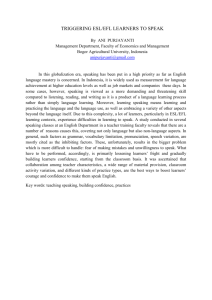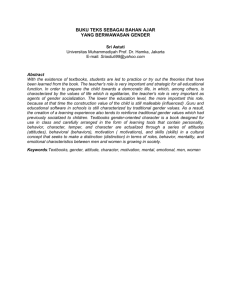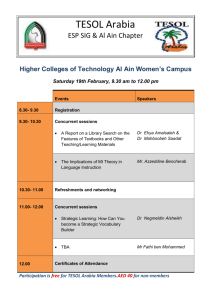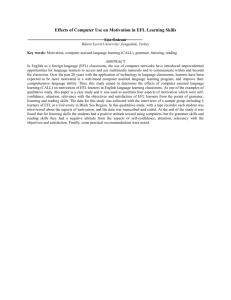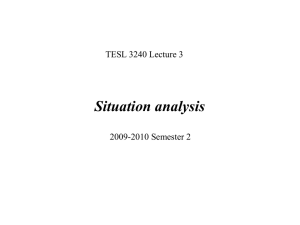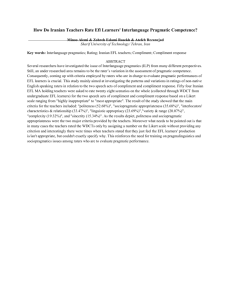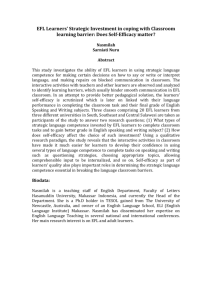English Non-Localized Textbooks national identity
advertisement
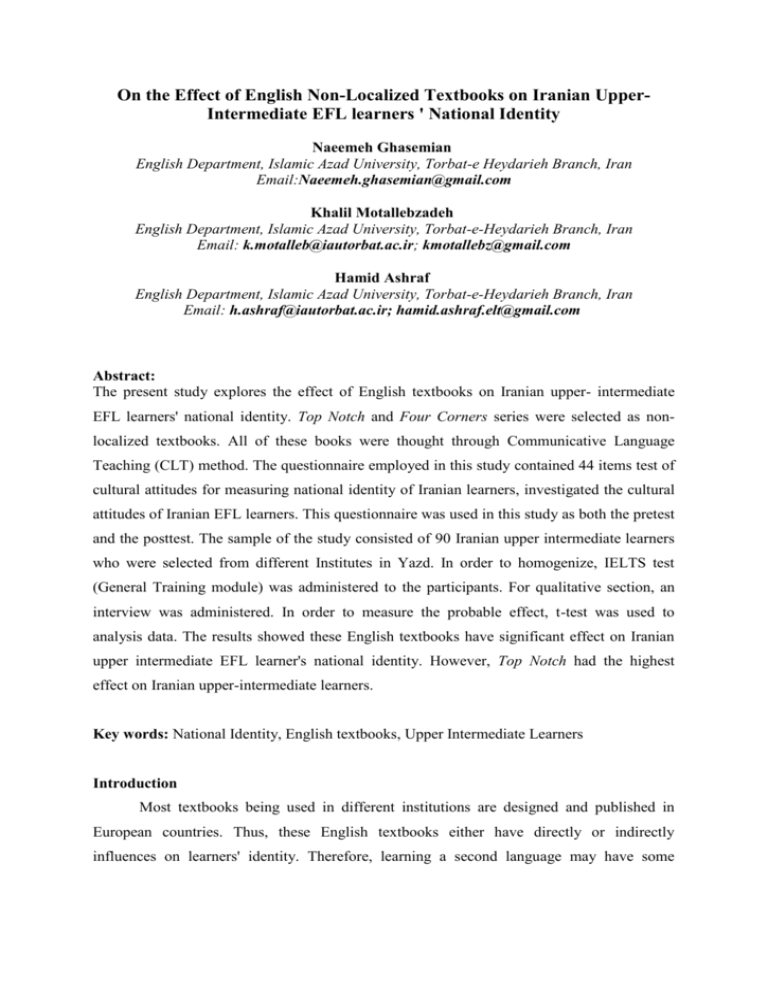
On the Effect of English Non-Localized Textbooks on Iranian UpperIntermediate EFL learners ' National Identity Naeemeh Ghasemian English Department, Islamic Azad University, Torbat-e Heydarieh Branch, Iran Email:Naeemeh.ghasemian@gmail.com Khalil Motallebzadeh English Department, Islamic Azad University, Torbat-e-Heydarieh Branch, Iran Email: k.motalleb@iautorbat.ac.ir; kmotallebz@gmail.com Hamid Ashraf English Department, Islamic Azad University, Torbat-e-Heydarieh Branch, Iran Email: h.ashraf@iautorbat.ac.ir; hamid.ashraf.elt@gmail.com Abstract: The present study explores the effect of English textbooks on Iranian upper- intermediate EFL learners' national identity. Top Notch and Four Corners series were selected as nonlocalized textbooks. All of these books were thought through Communicative Language Teaching (CLT) method. The questionnaire employed in this study contained 44 items test of cultural attitudes for measuring national identity of Iranian learners, investigated the cultural attitudes of Iranian EFL learners. This questionnaire was used in this study as both the pretest and the posttest. The sample of the study consisted of 90 Iranian upper intermediate learners who were selected from different Institutes in Yazd. In order to homogenize, IELTS test (General Training module) was administered to the participants. For qualitative section, an interview was administered. In order to measure the probable effect, t-test was used to analysis data. The results showed these English textbooks have significant effect on Iranian upper intermediate EFL learner's national identity. However, Top Notch had the highest effect on Iranian upper-intermediate learners. Key words: National Identity, English textbooks, Upper Intermediate Learners Introduction Most textbooks being used in different institutions are designed and published in European countries. Thus, these English textbooks either have directly or indirectly influences on learners' identity. Therefore, learning a second language may have some consequences such as loss of identity, changes in beliefs that might lead to alter culture and influencing individual and social behavior. Estel (2002) points out that: National identity is a measure of self-identity, which permits a person to belong to which country or countries, nation or nations and feel closely connected to the members of that community. Therefore; one aspect of collective identity is national identity which is defined as its interpretation by the members of that collective not the systematic connection which is built by human beings (p. 108). Thornbury (2006) states that the extent to which a language learner is identified with speakers of the target language might effect on their motivation and their success or failure. Similarly, their second language identity may support or threaten their first language identity, too. According to Guibernau (2007), national identity is defined as a collective sentiment based on the belief of belonging to some nation. This belief shares most of the attributes that make it different from other nations. The present study is an attempt to investigate the effect of English textbooks on Iranian upper-intermediate foreign Language learners' national identity. The researchers try to consider how EFL learner's national identity is influenced by the English textbooks; in other words, the question is whether English textbooks could have any significant effect on Iranian upper intermediate EFL learner's national identity. LITRITURE RIEVIEW Thornbury (2006) believes that identity is not a stable, unified entity. Instead, people construct many identities out of attributes of their gender, ethnicity, job, family, relationship and so on those change a lot. The notion of identity is a very broad concept. It encompasses different dimensions such as individual, public, ego, social, cultural, and national identity. Therefore, learning a foreign language may have significant effects on identity, especially the national one. According to Bloom (1990), national identity is defined as a condition in which most people have made the same identification with national symbols and they attempt to internalize the symbols of the nation - so that they may act as one psychological group when there is a threat, or the possibility of enhancing these symbols of national identity. According to Piller (2007), actual identity of each person includes a sense of continuity, a sense of uniqueness from others, and a sense of affiliation. Identity helps individuals recognize themselves as separate and distinct entities. Related Studies Few studies have investigated ELT textbooks in Iran. For example, Abbasian and Khajay (2011) studied English language teaching in public schools in order to investigate the textbooks in relation to national identity and globalization in Iran. They used three ELT textbooks, which were published by ministry of education, taught at Iranian high schools, to examine if they were suitable for the age of globalization. The results of the study clearly indicated that high school textbooks have not been successful in familiarizing students with cultural matters of other countries. Therefore, the results illustrated that the percentage of textbooks materials related to globalization was very limited. The percentage of textbooks materials related to national identity was quite inadequate. This study revealed that current ELT textbooks, which are being taught in Iranian high schools, were not efficient at the age of globalization. Mozaheb. and Behnam, (2013) studied identity, religion, and new definition of inclusiveness in Iranian high school EFL textbooks. The main aim of their study was to investigate the relationship between religion and education in Iranian EFL textbooks. The instruments were "English 1, 2, 3", written by Iran' ministry of education. These researchers used non-linear and linear analysis. The result demonstrated that there was only two explicit mentioning of word "Islam" in book one. Scan of the dialogues demonstrated that the participants engaged in the dialogues were mostly from the same sex or they had relative relationship for instances both males and females were either father and daughter or brother and sister. Therefore, the findings of this study revealed that religion was an integral part of Iranian EFL textbooks, which taught indirectly. In addition, Iranian EFL textbooks promote Islamic notions and ideology regarding theocratic countries. Najafi and Rashidi (2010) studied the representation of culture in Iran Language institute advanced level textbooks. The results indicated that in Advanced one and two most of the sentences were of no reference and culture free statements. In addition, there were 1749 sentences in all these books, 420 sentences did not have no references culture. However, in Advanced three and four, most of the sentences did not have any specific statements referring to culture. Zarei, G. R. (2011) examined cultural effects of L2 learning on Iranian learners learning English. In order to figure out the cultural issues used in English textbooks, the researcher compared the learners of English who were taught special books (Interchange) with those not yet treated with the books. A questionnaire was administered to collect data from two groups of English Language learners. They were selected from an English Language Institute in Isfahan, Iran. The research findings showed learning English largely modified the language learners’ perceptions of cultural issues. The conclusion was that textbooks could make learners conceptualize the world as designated therein. Asgari (2011) examined the compatibility of cultural value in Iranian EFl textbooks. Analyzing the ideological content of textbooks is one of the major issues in critical linguistics and language education. In her study, she attempted to find the cultural values, which were used in EFL books and tried to find their influence on Iranian learners. In addition, the researcher tried to detect the differences between culture and language among learners and evaluate the relative importance of language. The instrument, which was selected for analyzing was one set of textbooks -interchange series- which were taught in English language institute in Iran. The result illustrated that new interchange series do contain cultural values. Although, the results showed that cultural impact did not just occur through one book. On the other hand, the results found by the researcher illustrated that these cultural values did not influence learners studying these books differently from those who study English through another set of books. Therefore, the researcher believed that if foreign books are considered without bias, the learners in Iran could be encouraged to learn the positive values expressed in these books. Poorebrahim (2012) studied sociocultural identity in EFL textbooks. The main purpose of this study was to examine sociocultural identity of EFL textbooks, which have been prescribed for use in the Iranian high schools by the ministry of Education. The researcher selected English book 1, 2, 3, and Learning to Read English for Pre- University Students. The result demonstrated that the authors of the book did not illustrate clearly the final objectives of the curriculum. The short-term objectives remained unspecified in the introduction. According to the structural complexity, starting from less complex structures to more demanding ones, the authors of the books had sequenced the linguistic content of the materials. There were not any authentic English pictures in all of these books. Therefore, students had to look at culturally different pictures (Persian), but read and speak English. The language of the textbooks, being decontextualized, was not used to communicate meaning, and the main purpose of learning such "English" for Iranian students was to pass exams. The materials and contents utilized in the process of learning were not linguistically or culturally appropriate .The language used in our Iranian English textbooks was still based on the oldfashioned syllabus. While in contrast, language learning should be considered cyclical, the language learning was linear. Finally, the result of the study illustrated that the materials used in Iranian English textbooks did not take into account the creative aspect of language (culture) and sociocultural theory. The use of culture-based activities in the classroom-helped learners be familiar with the target culture. Therefore, the activities in the materials should involve the cultural values of the target language designed for every level. Javadi and Javadi, (2008) studied the national identity and globalization among 165 undergraduate students of the Payame Noor University in Islamabad and Gilane gharb cities in Iran. They selected participants from these cities because most of their populations were Kurds and Kurds were considered as an ethnicity in Iran. In this study, national identity was considered as the pendent variable and age, sex, the degree and the kind of internet, satellite and VCD use, in addition to family, friends, facility, satisfaction with education and life and job in Iran, were considered as independent variables. As a result, they illustrated that the use of sexual environment of the Internet, satellite programs and their kinds, VCD and related programs had a negative effect on national identity. On the other hand, they considered that the other factors including facilities of welfare in the nation of Kurds, intimacy with family; had a positive effect on national identity. STATEMENT OF THE PROBLEM Learning English as an international language has many implications for EFL learners. For instance, learners spend more time in acquiring English and thus comparatively less time remains for their native language so their proficiency in the native language becomes weak. In addition, learning a second language may have some consequences such as loss of identity, changes in beliefs that might lead to alter culture and influence individual and social behavior. On the other hand, most textbooks being used in different institutions are designed and published in European countries. Thus, these English textbooks (Nonlocalized) either have directly or indirectly influences on learners. Therefore, it has been frequently investigated by many researchers including Ashraf, Motallebzadeh and Kafi (2013) who investigated the relationship between English textbooks and cultural attitudes of Iranian EFL learners whose English proficiency was intermediate and upper intermediate. Based on the results the researchers proved that English textbooks, Interchange and Top Notch series, have had a significant impact on learners’ cultural attitudes. Moreover, it was also stated that EFL learners were interested in Interchange series rather than American File series. Research Questions The present study will address the following research questions: Q1. Do Four Corners English textbooks have any significant effect on Iranian upper intermediate EFL learner's national identity? Q2. Do Top Notch English textbooks have any significant effect on Iranian upper intermediate EFL learner's national identity? Research hypotheses In order to avoid subjectivity and any other prediction, and based on the questions, the researcher proposed the following results: HO1. Four Corners English textbooks do not have any significant effect on Iranian upper intermediate EFL learner's national identity. HO2. Top Notch English textbooks do not have any significant effect on Iranian upper intermediate EFL learner's national identity. Methodology Participant In this study, the researchers selected 90 upper intermediate EFL learners from different language institutions in Yazd, Iran. The age of participants ranged from 16 to 45 and their level of proficiency was upper-intermediate. The researchers assigned the participants into two groups: experimental group and control group. Participants in experimental group (N=45) had all passed all Four Corners textbooks. The other group control group (N=45) included the Iranian upper-intermediate EFL learners who had passed all Top Notch textbooks. It should be mentioned that the participants in all groups were taught through the same method "Communicative Language Teaching"(CLT). The institutions use CLT method for teaching, this is mentioned in the introduction of their books. Therefore, the researcher asked the regular English teachers to teach the required English textbooks according to the method. Instrumentation The instruments used in this research were both qualitative and quantitative. International English Language Testing System Test (IELTS) In order to make sure that all participants were homogeneous, the participants in this research were required to pass IELTS test (General Training module) developed by University of Cambridge ESOL examinations (2009), which could indicate the learners' upper- Intermediate level of proficiency. Those participants who could score 6 above were selected. Out of 120, 90 female participants were picked for the purpose of this study. (See Appendix A) National Identity Questionnaire Acculturation test developed by Ashraf, Motallebzadeh and Kafi (2013) was employed to pinpoint the cultural attitudes of Iranian EFL learners towards the cultural elements which was embedded within the English textbooks. They claims that in their questioner, they study the national identity and Iranian culture of English learners who were exposed to English textbooks. This questionnaire included 44 items based on a five-point Likert scale, ranging from (1) “strongly agree” to (5) “no idea”. It should be noted that the reliability of the inventory was reported as 0.87 in Cronbah Alpha. The questionnaire is included in the appendix. The time allotted for answering the questionnaire was estimated to be 15 minutes.In addition, a bio-data section was included in questionnaire in order to provide some information about the learners' experience. National Identity Questionnaire was used as pretest and posttest. In order to respond the questions with no limitation, the researchers asked the participants not to write their names at top of the page and code the questionnaire by numbers or optional names. (See Appendix B ) Qualitative Data (Interview) For Qualitative section, a semi-structured interview was administered. According to the framework of the study, the researcher prepared four questions and interviewed eight participants for confirming the findings of the study. The interview had one section which was done face to face in twenty minutes. The questions were as follows: - Do you like to immigrate to English-speaking countries? Why ? - Is it interesting for you to learn English language? Why ? - Are you interested in the national identity of the English-speaking countries? -To what extent are you proud of being an Iranian? Procedure The administration of this research took place in May, 2013. Data collection was performed in two sessions for pre-test and posttest being held within 9 months. In the first phase, for homogenizing the participants of both groups and making sure about their general proficiency level, IELTS test (General Training module) was administered to the participants. Therefore, the students were put on the same level. It indicated that learners' proficiency was upperIntermediate level. The purpose of the second phase was to identify how English textbooks had effects on EFL learners ' national identity. Then, the researchers provided the questionnaire. Participants in both groups took pretest. In the next phase, after 9 months, the participants were asked to fill out the attitude language learning and national identity questionnaires again, in order to find out whether their national identity would have been impressed by using different kinds of English textbooks. The researchers interviewed with eight EFL learners in order to extract their exact idea about English textbooks and to identify whether they had any significant effect on Iranian learners’ national identity. Finally, according to descriptive statistics, the effect of English textbooks on Iranian EFL learner's national Identity was measured. Moreover, interviews with participants confirmed the accuracy of the results. The obtained data was analyzed by the employment of SPSS software. DATA ANALYSIS In order to answer the research questions, SPSS software was run to carry out the analyses. Results obtained from the analyses are demonstrated as follows, and the researchers have tried to address research questions and research hypotheses. Participants’ Demographic Analysis In addition, a bio-data section was included in questionnaires in order to collect information about learners. In this section, gender, age, learning experience, their English proficiency, name of the language school they were studying at were given. Table 1: Results of Bio-Data (Age) Frequency Percent Age under 18 years 7 7.8 18-20 13 14.4 20-30 64 71.1 30-40 6 6.7 total 90 100 Language Learning Experience Less than a year 1 1.1 1-2 years 0 0 2-3 years 17 18.9 3-4 years 33 36.7 Over 4 years 39 43.3 total 90 100 English Proficiency Excellent Very good Good Weak Too weak Average total Language Institute Four Corners Top notch total 27 28 27 0 0 8 90 30 31.1 30 0 0 8.9 90 45 45 90 33.3 33.3 90 According to table 1, it can be seen that 7.8 percent of the participants were under 18 years, 14.4 percent were between 18-20, 71.1 percent were between 20-30, and 6.7 percent were between 30-40. Thus, the highest percentage of participants, that is 71.1% were in the age group of 20 to 30 years. Also about language learning experience 1 percent were below 1 year, 18.9 percent were between 2-3 and 36.7 percent were between 3-4, the highest percentage of the participants i.e. 43.3 percent were related to the learners who have passed the language courses over four years. According to the results of the English Proficiency, 31.1 % percent of the participants’ skill levels were good, 30% were excellent or very good, 8.9 percent were average. To analyze the related data Statistical Package for Social Sciences (SPSS), version 21 was used to analyze the gathered data. The level of significance was 0.05. Table 2: Results of Paired samples Statistics for National Identity, Experimental Group (Four Corners) Paired Differences 95% confidence interval of the Difference Mean SD Std. Error Mean Lower Upper t df sig. (2-tailed) Pair1 Pretest posttest -.5256 .54818 .10008 According to table 2, [t(29)=-5.252, p=.000 -.7303 -.3209 -5.252 29 .000 (two-tailed)] there is significant effect on national identity between pretest and posttest and the null hypothesis was rejected. Table 3: Results of Paired samples test for National Identity, Control Group (Top Notch) Paired Differences 95% confidence interval of the Difference Mean SD Std. Error Mean Lower Upper t df sig. (2-tailed) Pair1 Pretest posttest -.6337 .33481 .06217 -.7611 -.5064 -10.193 28 .000 Table 3 revealed that [t(28)=-10.193, p=.000 (two-tailed)] there is no significant effect between pretest and posttest in the terms of national identity. DISCUSSION AND CONCLUSION To answer the research questions, as mentioned before, for Non-localized English textbooks Top Notch and Four Corners were selected. The results of the analysis reveals that Top Notch series English textbooks has effected %63 on national identity ' learners. Four Corners %52 influenced on Iranian national identity learners. The results obtained in the study show that the Non-localized English textbooks, published in Cambridge, had a greater impact on national identity ' learners. This finding is in line with that of Ashraf, Motallebzadeh and Kafi (2013) . The result of their study proved that English textbooks of Interchange and Top Notch series, had a significant impact on learners’ cultural attitudes. Besides, it stated that EFL learners preferred Interchange series rather that American File series. Therefore, through the analysis of the Interchange and Top Notch series in this study, the results indicated that textbooks were artifacts, which were strongly grounded in cultural assumptions and biases. These are all along with the result of this study which showed Non-localized text books as more effective. The researchers interviewed with eight learners in order to extract their idea about English speaking countries, their own country and why they were interested in learning English. The result of interview showed that learners of both groups were intended to immigrate to foreign countries and their aim was to improve their English language. Thus, they can communize with English speaking countries and also get familiar with native accent. However, during learning English, culture and lifestyle of English speaking countries have little impact on them. They were proud of being an Iranian. They respected their culture and they believed that our country had a rich history and literature and Iranian people were lovely and so kind. They were interested in learning English because it was the easiest language among other languages and it was the International language. In order to find a good job and continue their education they needed to know English. In order to reduce the effect of these series of non- localized books on learners' national identity the teachers can provide a situation to improve the Iranian national identity. When teachers teach topics which are related to English speaking countries they can emphasize on Iranian lifestyle and besides the culture of other countries make students aware of Iranian culture. Since Cambridge Press publishes most English textbooks, which are taught in different institutions in Iran, the material developers while choosing the books, should consider the national identity of learners to pay attention how much these series of books could have effect on Ideological beliefs and values of learners. Instead of omitting the Iranian names and Information about our culture, our society, our history, and geography of our country, they should emphasize on these subjects in books. On the other hand, in order to choose the book, material developers should consider the effect of the textbooks on learners' identity. (DE)LIMITATIONS OF THE STUDY The present work intended to find out which textbooks had more effect on national identity. In its definition Identity has different dimensions: Individual Identity, Public Identity, Social Identity, Ego Identity and National Identity. Other studies can be done about the effect of each one of these different dimensions of identity on EFL learners who study localized and Non- localized English textbook. For example, in terms of Individual identity, other studies are also suggested to investigate "the relationship between Iranian Individual identity of English teachers and teaching other Cultures to EFL learners ","the effect of English textbooks on Iranian EFL Learners' Social identity" and " the effect of English textbooks on Iranian EFL Learners' Public identity". REFERENCES Abbasian, R. &Khajavi, Y. (2011).English language teaching national identity and globalization in Iran: the case of public schools.International Journal of Humanities and Social Science, 1(10), 1-6. Asghari, A. (July 2011). The Compatibility of cultural value in Iranian EFL textbooks. Journal of Language Teaching and Research, 2(4), 887-894. Ashraf, H., Motallebzadeh, K., &Kafi, Z. (2013).On the relation between English textbooks andIranian EFL learners’ acculturation. Journal of Theory and Practice in LanguageStudies(TPLS),3(9),1658-1666. Behnam, B., Mozaheb, M.A.(2012). Identity, religion and new definition of inclusiveness in Iranian high school EFL textbooks.Procedia Social and Behavioral Sciences, 70 (2013 ),099 – 1108. Bloom, L. (1970). Language development: form and function in emerging grammars. Cambridge: MITPress. Cambridge ESOL, (2009). IELTS 7. United Kingdom: Cambridge University Press. Estel, B. (2002). Nation and national identity. Westdeutscher Verlag. Guibernau-Berdun M., (2007) . The Identity of Nations.Polity Press Javadi,A.M .,&Javadi.M.(2008).national identity and globalization. a survey among undergraduate students in Islamabad and Gilanegharb Cities (Iran), 45, 112-121. Najafi, R., &Rashidi, N.( September 2010). The Representation of culture in Iran language institute advanced level textbooks. Journal of Language Teaching and Research, 1( 5), 624-631. Piller, I. (2007). Linguistics and intercultural communication. Language and Linguistics Compass, 1/3, 208-226. Poorebrahim, F. (2012).Sociocultural Identity in EFL textbooks of Iranian high schools: An attempt to fill in the gap, Iranian EFL Journal, 8(4), 337 – 357. Thornbury, S. (2006). Second Language Acquisition And ELT. London: University of East London. Zarei, G.R . (2011). Cultural effects of L2 learning: a case study of Iranian learners learning English. Procedia Social and Behavioral Sciences,15, 2048–2053
